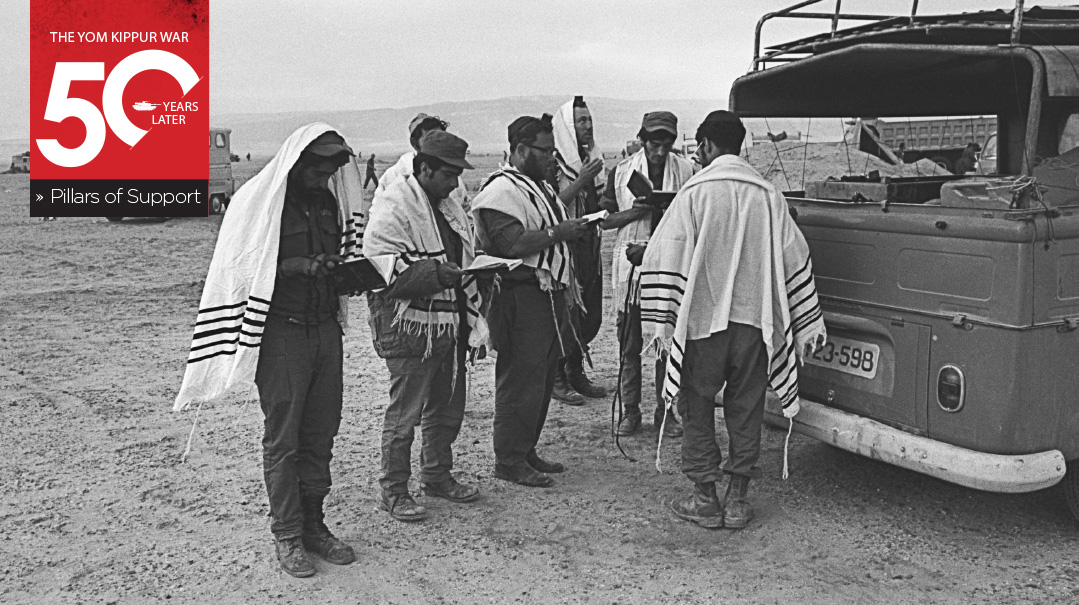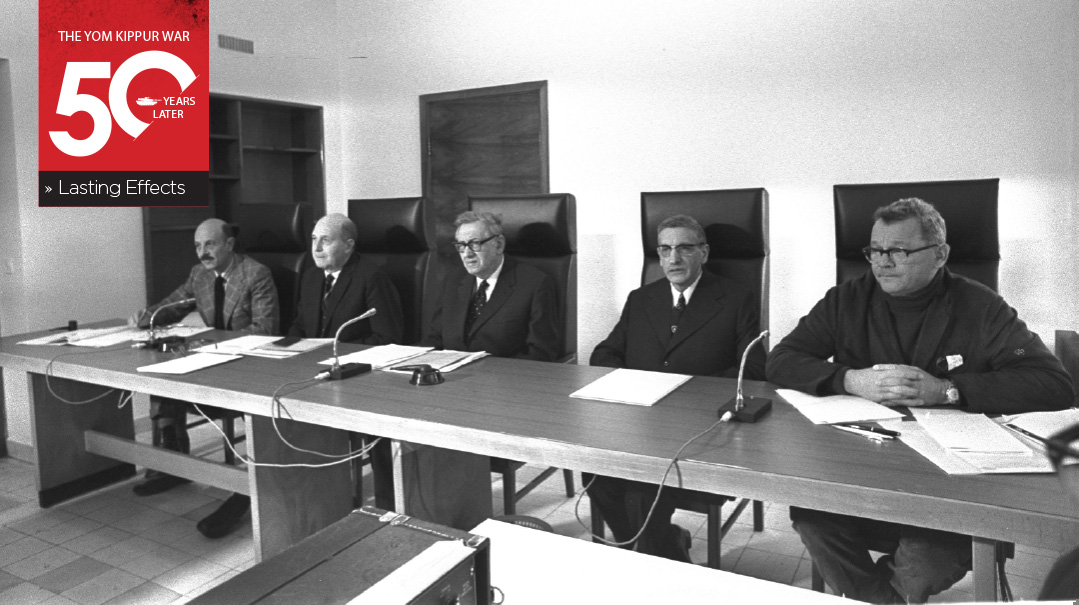Mysteries and Miracles

Two facts emerge that show how much worse the war could have been

Photo: Menachem Kalish
TO read about the days leading up to the Yom Kippur War is to experience the nightmarish, helpless feeling of watching a deadly car crash unfold, in slow motion.
As Yom Kippur of 1973 approached, ready to wreathe the Holy Land in an atmosphere of sanctity, only a small number of Israelis saw the black war clouds piling on their country’s borders.
But the military leaders — privy to the aerial intelligence that displayed the frightening disparity of forces in favor of Israel’s Arab enemies — saw it all, and did nothing.
On the west bank of the Suez Canal were arrayed 100,000 Egyptian soldiers, accompanied by 1,350 tanks and 2,000 artillery pieces. Facing this buildup, on Israel’s bank, were the few hundred men left to guard the Canal, backed up by a mere 44 artillery pieces and 290 tanks.
Reconnaissance photos of the northern border showed a similar picture. Five Syrian divisions confronted a thin line of Israeli outposts atop the rocky Golan Heights. The disparity in Syria’s favor was shocking: Not only did they have an 8-to-1 advantage in armored forces — their Soviet-made tanks were equipped for night-fighting, whereas Israel’s would be blinded after dark. In infantry and artillery, the odds were stacked even more heavily in the Arabs’ favor.
Those statistics, and the fact that Israel’s defense chiefs weren’t unduly alarmed, is the story of the Yom Kippur War — one that has been endlessly rehashed in the last half-century.
It’s the story of what became known as “the Concept” — the flawed military intelligence assessment that dictated that Egypt wouldn’t go to war with Israel without the aerial superiority that they lacked.
It’s the story of how, under the influence of her intelligence chiefs, Golda Meir ignored separate tip-offs by Jordan’s King Hussein and by Nasser’s son-in-law Ashraf Marwan that Egypt and Syria nevertheless intended to do the unthinkable and launch an attack.
And it’s the tale of the thousands of Jewish boys who were condemned to death and injury in the resulting war.
As Yom Kippur approaches each year, and the radio waves fill with the horrifying recordings of Israeli soldiers under attack in the Suez Canal outposts, that narrative dominates.
But while utterly true, it’s not the only possible storyline. Because, when you strip away the fog of battle, to focus on the framework of the events, two facts emerge that show how much worse the war could have been.
Within days of the devastating losses of the war’s opening phase, the IDF was shelling Damascus from inside Syrian territory. Israel had the Egyptian army by the throat, having encircled Sadat’s forces by crossing the Suez Canal into their rear areas.
In pure military terms, that stunning turnaround was down to two events that are mostly overlooked. One is the mysterious fact that the Syrians failed to capitalize on their breakthrough in the southern Golan Heights on the opening day of the war, to drive unopposed across the Jordan River into Israel proper.
The second is that the crucial military play of the war — Israel’s crossing of the Suez Canal in between two Egyptian armies — was only possible because a gap between those armies existed.
Game Changers
Visitors to the Golan Heights are often struck by the fact that the plateau is like an open-air war museum. Yellow skull-and-crossbones signs flutter on the barbed wire fences, warning of the old minefields that abound. In the fields along the route of the Gamla Ascent — a route up to the Golan from the Kinneret — a T-62 tank rusts in the sun, a reminder of how far the Syrians penetrated.
In the stronghold of Tel Saki near the current Syrian border and the religious moshavim of Hispin and Ramat Magshimim, the blasted concrete walls tell the tale of the desperate battle waged by the outpost’s occupants.
Further north, a few Israeli Centurion tanks stand sentinel at the site of the famous battleground whose name, Emek Habacha, or the “Valley of Tears,” is taken from Lecha Dodi.
Like any conflict, the battle that raged over the Heights and by the Suez Canal 50 years ago was a complex series of blow and counter-blow. But stripped down, the over-arching narrative resolves itself into two basic dynamics.
First, the Arab armies could declare victory simply by capturing small amounts of Israeli territory. Second, because of technological advances, Israel’s main tools for deterring such land grabs were practically useless.
On the Suez front, Sadat’s dual aims to restore Egyptian pride and force Israel to give up Sinai could be achieved without conquering Israel proper. All he needed to do was humble the IDF by dislodging it from the Canal, and holding that captured ground in the face of Israel’s armored and aerial might.
Similarly, on the Golan Heights, Syria could achieve its war aims of recapturing the strategic high ground within 12 hours of the war’s beginning, before Israel could mobilize its reserves.
The game-changer for Egypt and Syria was that they had weaponry that neutralized the IDF’s advantage. From its inception, Israel’s military doctrine had relied on its air and armored forces to deliver a devastating — and quick — knockout blow that would offset the Arabs’ numerical advantage, and prevent attacks on Israel’s cities.
That had worked in 1956 and in 1967, but it failed in 1973, with the dawn of the missile age. The Soviet supplied SAM anti-aircraft missile systems and infantry-born Sagger anti-tank weapons were revolutionary. Overnight, they destroyed Israel’s ability to roam free above the battlefield, and enabled a lone infantryman to be able to take on the mighty tank.
In the opening days of the Yom Kippur War, the obsolescence of Israel’s military doctrine in the face of the fearsome missile threat was demonstrated in deadly fashion. Dozens of fighter jets were shot out of the sky, and an armored counter-attack against the Egyptian beachhead was stopped in its tracks by infantry loaded with anti-tank weaponry.
Land Grab
Amid the black gloom that descended on Israel’s leadership, two battlefield events occurred that sealed the war’s fate in Israel’s favor. The first was on the Golan. While attention has focused on heroic battle such as that in Emek Habacha, less studied is what happened on the southern Golan where Syrian armored forces broke through en masse.
“In the absence of any account of the war by authoritative Syrian sources,” wrote Abraham Rabinovitch in his seminal history The Yom Kippur War, “the reason that they did not continue their attack at night after breaking through in the southern Golan is one of the major remaining mysteries of the war. Despite fierce resistance, the Syrians succeeded in inserting hundreds of tanks capable of reaching the Jordan bridges virtually unopposed.”
A few hours spent on the Golan is enough to understand how dramatic that failure to press home the attack was. From the top of the Gamla Ascent or the road down to the Jordan River at the Heights’ southernmost extreme, the Galil and northern Israel are spread out in all their beauty.
A column of Syrian tanks driving down one of these roads would have easily been able to capture Israeli villages or even a small town, delivering a shattering blow to Israeli morale. Even if the Air Force had intervened, the likely capture of Israeli civilians would have given Damascus an immense lever in negotiations.
Things are equally mysterious on the southern front. Sadat’s strategy of a limited land grab worked perfectly in the war’s opening stage: Israel’s armor and air force blunted itself on the impregnable Egyptian beachheads bristling with Sagger and SAM missiles. It became clear that rolling back Egyptian forces from their entrenched positions on the Israeli bank of the waterway was almost impossible.
Israel’s fightback began when forces under General Avraham Adan crossed the Canal and proceeded to wreak havoc in the Egyptian army’s rear, shooting up supply dumps and SAM missile sites, and eventually cutting off supplies to Sadat’s Second and Third Armies, and threatening a move on Cairo, just 40 kilometers away.
Here again, the much-mythologized Canal crossing has been discussed in terms of the precariousness of the effort given the fact that it relied on ridiculously antiquated and vulnerable equipment.
Without detracting from that narrative, surely an equally great emphasis should be placed on the fact that there was a space to do it at all.
“The IDF was taking an enormous risk in attempting to infiltrate the bulk of the army through the middle of the enemy line, across a water barrier, with a single pontoon bridge and only a narrow unsecured corridor to the rear,” wrote Rabinovitch.
But the crucial fact is that it was a gap between the two Egyptian armies that enabled the IDF to cross at all. The Second Army was responsible for an area up to Deversoir, north of the Great Bitter Lake on the Canal, and the Third Army’s jurisdiction started south of the lake, leaving a gap a few miles wide to exploit.
It took the Egyptian High Command a crucial two days to realize that a large-scale crossing was underway, and by then the die was cast. It was only Kissinger’s direct intervention that ultimately saved the Egyptian Army from a repeat of the 1967 humiliation as the IDF enveloped the Egyptian forces on the Israeli bank of the Suez Canal, and cut off all food and water supplies.
Fifty years on, Israel still tastes the bitter ashes of near defeat and national humiliation unleashed by its own leaders’ hubris. But with time comes perspective. Alongside all the political and national security analyses that the cataclysmic war prompt, there is room for a fresh appreciation of the near-miraculous string of events that enabled a recovery from near defeat to victory.
The Yom Kippur War was the first conflict in which large numbers of soldiers in religious units proved their worth, and its legacy should be one of faith as well, a study of which could focus on two key questions. Why did the Syrians retreat, and why was there a gap between the two Egyptian armies?
The emergence of valid military and operational reasons for these two points shouldn’t detract from the fact that alongside the needless horror and suffering of the Yom Kippur War, these fateful turning points highlight the hidden miracles and Divine Providence of Israel’s bloodiest conflict.
(Originally featured in Mishpacha, Issue 980)
Oops! We could not locate your form.






